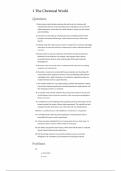1 The Chemical World
Questions
1. Soda contains carbon dioxide molecules that are forced into a mixture with
watermolecules because of the increased pressure. Opening the can of soda will
release thepressure, which allows the carbon dioxide to escape from the mixture
and formbubbles.
2. Chemicals are what make up everything around us, including ourselves! Some
examples of chemicals include sugar, carbon dioxide, and water, which make
upsoda.
3. Chemists study the world around us and try to explain how it works. By studyingthe
interactions of atoms and molecules, chemists hope to better understand theworld
around us.
4. Because matter is made up of molecules, the behavior of matter is dictated by
thebehavior of the molecules. For example, water expands when it freezes
becausethe distance between water molecules gets farther apart during the
freezingprocess.
5. Chemistry is the science that seeks to understand what matter does by studying
whatatoms and molecules do.
6. Chemistry is connected to everyday life because molecules are interacting with
youto produce all the experiences you have, from your dreaming while asleep to
watchingthe stars at night. Chemistry is not confined to a laboratory unless you
consider theentire universe a giant laboratory.
7. The scientific method is a way of approaching a problem that emphasizes making
observations, planning experiments, performing experiments, analyzing data, and
then using logic tocome to a conclusion.
8. An example of the scientific method being used from this chapter is the discovery
ofwhat happens during combustion reactions, which requires proving phlogiston
theory as incorrect.
9. A scientific law is a brief statement that summarizes previous observations and can
beused to predict the results of future related experiments. The scientific law does
notexplain why the observations occur. That is the role of a scientific theory.
10. Before a scientific theory is well established, it is referred to as a hypothesis.
11. A scientific theory is the best current explanation of a phenomenon that has
beenvalidated by years' worth of experiments.
12. Antoine Lavoisier established the law of conservation of mass, which states, "In
achemical reaction, matter is neither created nor destroyed."
13. John Dalton proposed his atomic theory, which states that all matter is composed
ofsmall, indestructible particles called atoms.
14. The three things needed to succeed in this chemistry course are curiosity,
willingness to do calculations, and commitment to learning the material.
Problems
15.
a. observation
h th,c,nn,
, c. law
d. observation
16.
a. observation
b.law
c. theory
d. observation
17. Examination of the data table reveals that when the mass of the gas increases, a
corresponding increase in the volume of the gas occurs. Two equivalent ways
ofexpressing this information as a scientific law would be: (1) the mass of a gas
isdirectly proportional to its volume or (2) the mass-to-volume ratio of a gas is
constant.
18. Examination of the data table reveals that when the kelvin temperature of the gas
increases,acorresponding increase in the volume of the gas occurs. Two equivalent
ways ofexpressing this information as a scientific law would be: (1) the kelvin
temperature of a gasis directly proportional to its volume or (2) the kelvin
temperature-to-volume ratio of a gas is constant.
19.
a. The reactivity of anatom is related to the atomic size.
b. Reactivity is due to the momentum of collisions, and because the larger
atomshave a greater momentum, they have a greater reactivity.
*Remember this problem is for an imaginary universe!*
20.
a. Water is always made up of 1 part hydrogen to 8 parts oxygen by mass.
b. Carbon dioxide is always made of 8 parts oxygen to 3 parts carbon by mass.
c. A compound is always made of atoms of two or more elements combined in
a specificmass ratio.
d. A compound is made up of a specific ratio of atoms of each element.
Questions for Group Work
21. The company is using consumer fear of" chemicals" to imply that their product
issafe. The "no chemicals" could refer to additives, preservatives, pesticides,
orinsecticides, which are all groups of chemicals that many consumers do not
wantpresent in their products. A scientist would not find this statement correct
because allmatter is composed of chemicals.
22. Answers may vary; a representative group of answers: water, carbon dioxide,
oxygen,nitrogen, carbon monoxide, copper, gold, aluminum, iron, lead.
23. Your answers must be consistent with the following definitions:
Observation: a measurement or description of some aspect of the physical world.
Law:a statement summarizing the results of a large number of observations.
Hypothesis:a tentative interpretation of a group of observations.
Theory: a model that explains and gives underlying causes for observations and
laws.




